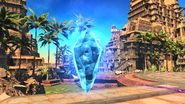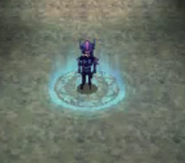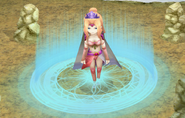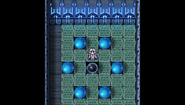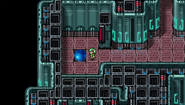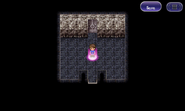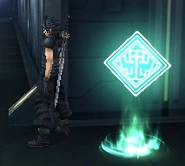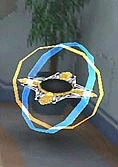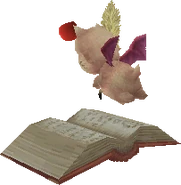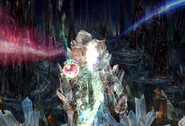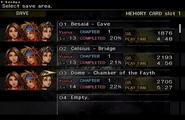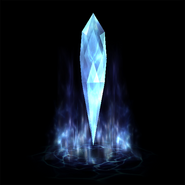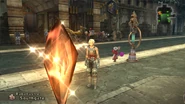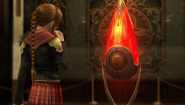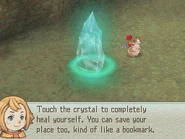Template:Sideicon
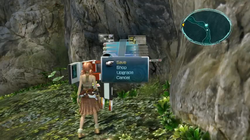
A Save Station in Final Fantasy XIII.
The save point (セーブポイント, Sēbu Pointo?) is used in the Final Fantasy series in addition to inns as a place to save and heal a party's MP and HP by setting up a tent, cabin, cottage, or house. The world map tends to be one huge save point, as it is possible to save at any time while on the map; however, towns and dungeons have specific save points which are clearly marked, which the player must activate either by touching it or standing on it.
A save point tends to be placed right before a particularly hard point in a dungeon, as a breather in a long run of battles, or before a boss battle. As of Final Fantasy X, save points automatically heal the entire party's HP and MP and fully cure the player of any status ailments, without the use of a tent. This effectively rendered the use of inns obsolete. In some games the player can also save at the end of each disc and during specific storyline points.
A quicksave feature was added to the portable remakes of the early Final Fantasy games as well as for Final Fantasy Tactics Advance. It allows the player to cease play at any point and resume when they wish, but the downside is that the save is only temporary (i.e. it is wiped when it is reloaded). As such, if the party falls in battle, the game will not return to a previous quicksave (as it has been permanently wiped), instead the player will either be forced to revert to his last actual saved game, or to restart from the beginning, if no prior saves exist. In the iOS/Android versions of Final Fantasy IV and Final Fantasy V, the game is automatically quicksaved after every battle or when the player moves to another screen.
Also, for the PlayStation versions of Final Fantasy and Final Fantasy II, as well as the fourth through the sixth installments, there existed a feature known as Memo Save. The Memo Save would save data to the PlayStation's RAM, and would stay intact as long as the PlayStation's power was not disrupted, through resetting the system, unplugging, and other methods. This was useful, as save points were sparse in the original games, and didn't even exist in the first two.
The Steam versions of Final Fantasy IV, The After Years and Final Fantasy IX were given autosave features that save the game either on entering a new dungeon area, or just before the start of the most recent battle. This can only be accessed by pressing "continue" from the main menu, and will be deleted if the player loads another save game.
Appearances
Final Fantasy IV
Save points (Special Fields in the SNES version) appear mostly as gray disks surrounded by three to eight pillars. In technological areas such as the Tower of Zot, they appear as black orbs set into the ground. The save point's graphic in the Feymarch and Sylph Cave appear as a Star of David on a beige tile.
In the Easy Type, and North American Final Fantasy II releases, they appear as a large "S" in a circle on a beige tile, similar to the Feymarch's save point. Technological areas have blue glowing save points instead of beige.
The save point in the 3D release has an entirely new design. It is a blue glowing circle on the ground, similar to Final Fantasy V save points, with star patterns within it.
Final Fantasy IV -Interlude-
The save points returns in the sequel to Final Fantasy IV, and works exactly the same way as it did in that game.
Final Fantasy IV: The After Years
The save points are no different than those of its predecessors.
Final Fantasy V
Save points are called Consecrated Circles, and appear as a round ring of light coming up from the floor. The party also can use a Tent or Cottage on a save point in order to restore HP and MP.
Final Fantasy VI
A strange light fills the air.
Description
A sparkling, star-like light serves as a save point. The party can heal their HP and MP with the use of Tents. If the party loses a random battle, the game will not display a Game Over screen, but instead play a short animation where the topmost character in the party raises from the ground, and the game will begin on the last activated save point.
In Kefka's Tower, Phoenix Cave, and the Dragon's Den, there is a glitch involving these points.
Final Fantasy VII
The save point appears shaped as a purple/green floating "C" letter (standing for "Checkpoint") with a green fire base. It can be used by moving the character onto it and opening up the menu when a little box appears. Players can also save on the world map whenever they please. As with many games, Tents can only be used on save points. Save points can also be used to access the PHS.
The save point glitch can be performed to fool the game to think the player is on a save point when they aren't, essentially letting the player save their game almost anywhere on the field. The PHS glitch concerns the event where Yuffie Kisaragi is recruited, where the player can use the fake save point on the field to access the PHS when this is not intended to be possible.
The item Save Crystal lets the player make a save point anywhere in the Northern Cave, although this can be dangerous as the feature is bugged.
Save points are largely removed from the game's demo versions. A save point can be found in the "Mt. Corel" PC version demo, but as the PHS and Save options are disabled, the player cannot make use of it.
Crisis Core -Final Fantasy VII-
Save points appear as the SOLDIER logo with a green mako base in the North American version. In the Japanese version, they have an S rather than the SOLDIER logo. They can also be used to access the Mission Mode.
Final Fantasy VIII
The save point takes the form of the Garden logo surrounded by two rotating circles. The game also has hidden save points that can only be detected and used if a party member has the Move-Find ability. Save points are only found in location areas as saving can be accessed via the menu screen when on the world map.
Final Fantasy IX
The moogles act as save points by bringing out a big leather-bound book to record the player's progress. Moogles don't exist in Memoria, thus explaining the reason why Memoria has glowing spheres which allow the player to save, use a Tent, and change party members. The final save point also allows the player to warp out of the dungeon.
Final Fantasy X
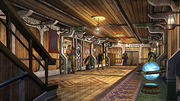
A save sphere on S.S Winno.
The save point is a sphere surrounded by a ring.
In general, there are three upgrades upon touching the save sphere and occur in this situations:
- Traveler's Save Sphere Level 1: Heals HP and MP. Available after defeating Sinspawn Ammes.
- Traveler's Save Sphere Level 2: Gives access to the Blitzball minigame. Available after arriving at the Mi'ihen Highroad.
- Traveler's Save Sphere Level 3: Gives access to the airship. Available after defeating Yunalesca.
Notably, there are a couple of instances in which non-playable characters can be seen making use of these spheres in Final Fantasy X.
After the events of Macalania Temple, when the Guado are pursuing the party, the player can see O'aka XXIII giving a brief wave goodbye before apparently using the sphere to teleport away. The cactuar called Elio also uses the save sphere during cactuar sidequest. Additionally, Braska can be seen using the one just before the Zanarkand Dome's Cloister of Trials in a flashback, possibly to restore HP and MP.
Final Fantasy X-2
The Save Spheres are the same as Final Fantasy X, although they no longer allow players to play Blitzball. They can, however, allow the player access to the airship and can fully restore the party's HP and MP as well as curing all status ailments.
The icon for a Final Fantasy X-2 save in the system browser is a PuPu for a normal save, and a Cactuar for a New Game+ save. The icon for a third playthrough is a moogle.
The International and HD Remaster versions include a feature called Creature Creator that allows players to view Fiend Tales for captured fiends after developing them. One of these involves a Nashorn who was accidentally teleported by a save sphere to Mt. Gagazet and then found by the Gullwings. He later returned to his cubs on the Mi'ihen Highroad, only to find them playing with another Save Sphere. He rushed over hoping to protect them, but ended up getting teleported again.
Final Fantasy XI
Due to the nature of an MMORPG, progress is constantly saved automatically on the servers. However, if a player's HP reaches zero and they decide not to wait for a Raise, they are warped back to their 'Home Point'. This is either the entrance to the Mog House or a blue crystal known as the Home Point. Players may only set one location as their Home Point at any time. Home Points were originally found only in towns, with only one crystal per zone. However, since the Dec 11, 2013 Version Update, numerous additional Home Points were added, including ones being placed right outside certain battlefield areas. Players are now also able to teleport between Home Points for a small fee.
The Warp spell will return the player to his current Home Point.
Final Fantasy XII
Save points come in the form of Save Crystals that come in two colors; blue, the standard Save Crystal, and orange, a Gate Crystal that can also teleport the player to other Gate Crystals. They also heal HP and MP and status ailments and restore all knocked out allies to life. Touching a Save Crystal breaks a battle Chain. Barheim Passage has a unique Save Crystal; the first time through the Save Crystal is blue, but if the party revisits the area later the Save Crystal has turned into a Gate Crystal.
A total of three Save Crystals take the form of enemies, Crystalbug (red), Crystalbug (blue), and Crystalbug (green), monsters that attack once the player inspects the crystal. Upon defeat, they turn into real Save or Gate Crystals.
Final Fantasy XIII
Save Stations appear as floating white consoles on the field map, and a chip icon with an "S" on the minimap. Players can also access the Retail Network and upgrade/disassemble equipment at Save Stations.
The game's sequels both had autosave and allowed the game to be saved manually at any time outside battle. Thus, save points were not necessary.
Final Fantasy XIV
Similar to Final Fantasy XI, large blue crystals called Aetheryte which exist in every major area and city serve as the point where the player is returned to when their HP reach zero.
In alliance raids, a save point can be found in front of each boss chamber.
Final Fantasy XV
The player can save anywhere on the overworld. The player can't usually save amid a dungeon or a quest, but in Chapter 13 and 14 the player can manually save at rest points. The player can have ten save files, two of which are auto-save slots.
In Final Fantasy XV: Episode Gladiolus, the player can save at havens. In Final Fantasy XV: Episode Prompto, the Ebony vending machines are save points. In Final Fantasy XV: Episode Ignis the player can save at rest spots.
Final Fantasy Type-0
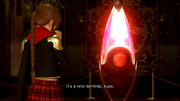
A Relic Terminal.

Artwork.
Save points, known as relic terminals (レリック端末, Rerikku Tanmatsu?) in context, appear as floating orange crystals with the kanji for "record" (録, Roku?) on top, depicting the design of Etro's gate. Relic terminals serve a more important function than just saving, as it allows the player to change the field character (Assignment), reserve party (Reserves), change equipment and equipped abilities (Armament), learn new abilities on the cadets and Eidolons and boost their stats (Promotion), access the Altocrystarium to upgrade magic, change difficulty level (Difficulty), and save and load saved games. When replaying missions, the Save function is absent, and the Difficulty setting is always disabled during missions.
Relic terminals draw their power from the Vermilion Bird Crystal, and thus Class Zero can use them. They are scattered across the land.
Final Fantasy Crystal Chronicles: Ring of Fates
Save points only appear in Story Mode, in the form of a large Crystal. They are usually in a area with no enemies and with a moogle nearby to give players a stamp. They heal all HP, SP, and status effects. In Multiplayer Mode, they become Checkpoints instead of save points. Players can only use it to heal and can restart here if they die in the dungeon but not return here if they turn off the game.
Final Fantasy Crystal Chronicles: Echoes of Time
Save points appear in both story mode and multiplayer mode. They allow the player to switch between story and multiplayer modes freely. Along with the multiplayer menu the player can also access a friend list and edit their preset phrases, usable to talk to partners.
Final Fantasy: The 4 Heroes of Light
The Adventurer acts as the save point and is always accompanied by the Faithful Fox who can give gameplay advice if needed.
Bravely Default
The Adventurer from The 4 Heroes of Light again acts as a save point found in towns and dungeons. In addition to selling a large stock of items that include sundries and rare equipment, which are unlocked as rewards from the Norende Village restoration.
Bravely Second: End Layer
The Adventurer once again acts as a save point and still sells items unlocked from the Fort-Lune restoration. The Adventurer's true identity is also revealed.
Final Fantasy Dimensions
World of Final Fantasy
Template:Sideicon In World of Final Fantasy, Teleport gates appear as save points. These allow Reynn and Lann to save the game, access their prismarium (without using up a seraphone), and teleport to and from Nine Wood Hills. These gates are gold in colour. Other gates are red and only allow them to exit from the current dungeon. The gates in Grymoire are around the same height as Reynn and Lann in "Jiant" form, but the one in Nine Wood Hills is much bigger, indicating the difference in scale between the two worlds. The game only has one save slot, and this is automatically synced to Square Enix's cloud servers without needing a Playstation Plus account.
Gallery
Template:Navbox recurring elements

